How to make the "Top 5 Danish Open-Faced Sandwiches" (Smørrebrød Recipes)
Denmark is renowned for many things: its happiness index, progressive social policies, and stunning landscapes. But perhaps one of its most delightful contributions to global cuisine is the beloved smørrebrød. This traditional open-faced sandwich is not just a meal; it's an art form, a representation of Danish culture, and a testament to the country's culinary creativity
NUTRITION
Peter
7/11/202410 min read
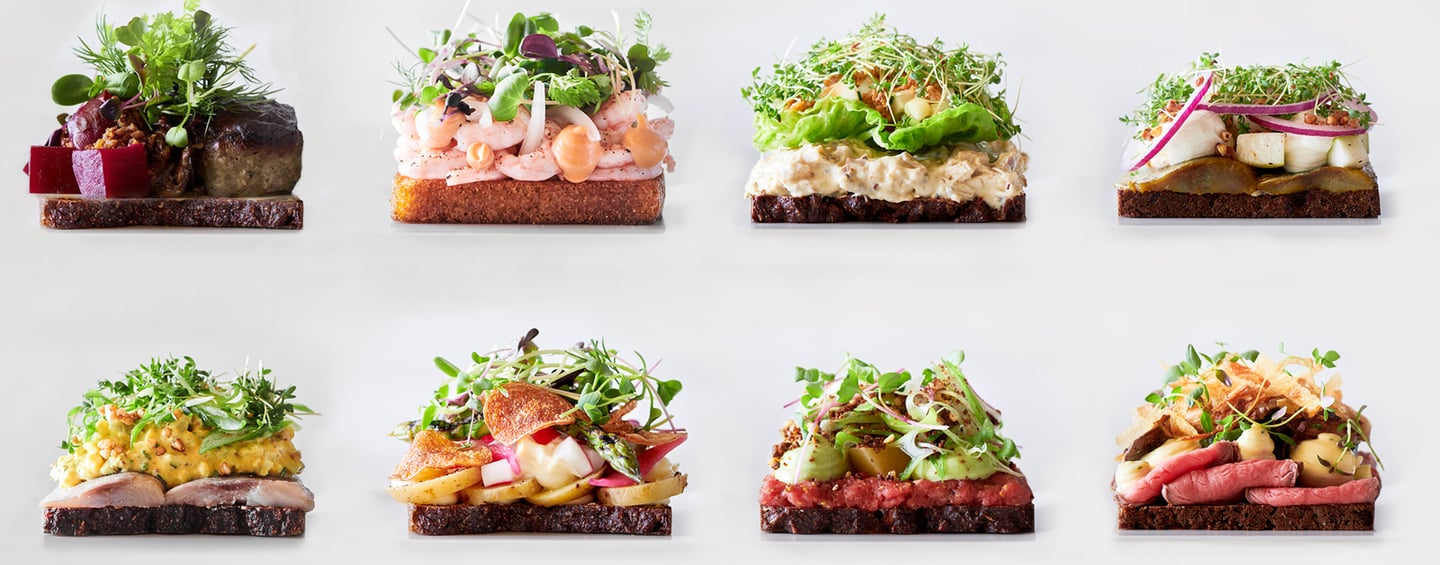

Danish Smørrebrød: My Culinary Journey Through Open-Faced Sandwiches
As a food enthusiast and lover of Danish cuisine, I've always been captivated by the artistry and flavors of smørrebrød. My journey through the world of these open-faced sandwiches has been nothing short of delightful, and I'm excited to share my experiences with you.
When I first visited Denmark, I was struck by many things: the palpable happiness of its people, the progressive social policies, and the breathtaking landscapes. But it was the beloved smørrebrød that truly captured my heart and palate. This traditional open-faced sandwich isn't just a meal; it's an art form, a representation of Danish culture, and a testament to the country's culinary creativity.
What is Smørrebrød?
During my culinary adventures, I quickly learned that smørrebrød, literally translates to "butter bread." However, this simple name belies the complexity and artistry involved in creating these open-faced sandwiches. At its most basic, smørrebrød consists of a slice of dense, dark rye bread (rugbrød) spread with butter and topped with a variety of ingredients. But in practice, it's so much more.
The foundation of any smørrebrød is the rugbrød, a sourdough rye bread that's dense, slightly sour, and packed with whole grains and seeds. This hearty bread provides a sturdy base for the often elaborate toppings and adds a distinct flavor that complements the other ingredients. I've come to appreciate how this bread, with its rich texture and complex taste, sets the stage for the culinary performance to come.
The art of smørrebrød lies in the careful balance and arrangement of toppings. Each sandwich I've encountered has been meticulously crafted, with ingredients chosen not just for their taste, but also for their visual appeal. The result is a beautiful, edible work of art that's as pleasing to the eye as it is to the palate. I've marveled at the skill of Danish chefs as they transform simple ingredients into stunning compositions.
History and Cultural Significance
As I delved deeper into the world of smørrebrød, I discovered that the concept of open-faced sandwiches dates back to the Middle Ages when thick slices of bread were used as plates. However, smørrebrød as we know it today began to take shape in the 19th century. As Denmark industrialized, workers needed a convenient, portable lunch, and smørrebrød fit the bill perfectly.
Over time, what started as a humble workman's meal evolved into a sophisticated culinary tradition. By the late 19th century, restaurants in Copenhagen were serving elaborately decorated smørrebrød, elevating the simple sandwich to an art form. I've had the pleasure of dining in some of these historic establishments, where the tradition of smørrebrød is treated with reverence and creativity.
Today, I've observed that smørrebrød is an integral part of Danish culture. It's enjoyed in homes, cafes, and high-end restaurants alike. It's a staple at celebrations, a go-to for business lunches, and a source of national pride. The care and creativity that goes into each smørrebrød reflects the Danish values of quality, simplicity, and aesthetic appeal – values that I've come to deeply appreciate during my time exploring Danish cuisine.
My Smørrebrød Journey
Throughout my culinary journey, I've had the opportunity to taste a wide variety of smørrebrød. From classic combinations to modern interpretations, each sandwich has told a story of Danish culinary tradition and innovation. I've learned to appreciate the subtle interplay of flavors and textures, from the crunch of freshly pickled vegetables to the richness of smoked fish or the earthiness of liver pâté.
One of my favorite aspects of exploring smørrebrød has been learning about the unwritten rules that govern their creation and consumption. For instance, I discovered that there's a specific order in which different types of smørrebrød should be eaten: fish first, then meat, and finally cheese. This attention to detail and respect for tradition has deepened my appreciation for Danish food culture.
As I continue my journey through the world of smørrebrød, I'm constantly amazed by the creativity and passion that Danish chefs bring to this beloved dish. From traditional favorites to innovative new combinations, smørrebrød continues to evolve while staying true to its roots. It's a culinary tradition that I've fallen in love with, and one that I'm excited to share with others.
In the following sections, I'll introduce you to some of my favorite smørrebrød varieties and share recipes that I've collected and perfected during my time exploring Danish cuisine. Whether you're a fellow food lover, a curious traveler, or simply someone looking to expand your culinary horizons, I invite you to join me on this delicious journey through the world of Danish open-faced sandwiches.
2. Roast Beef Smørrebrød
This classic smørrebrød showcases one of Denmark's favorite meats. Thinly sliced roast beef is paired with crispy fried onions, tangy remoulade sauce, and peppery watercress for a satisfying combination of flavors and textures.
Recipe:
Ingredients:
1 slice of rugbrød
Butter
3-4 slices of thinly sliced roast beef
2 tablespoons remoulade sauce
2 tablespoons crispy fried onions
Fresh watercress
Horseradish, grated (optional)
Instructions:
Spread a thin layer of butter on the rugbrød.
Arrange the roast beef slices to cover the bread.
Dollop the remoulade sauce over the beef.
Sprinkle the crispy fried onions generously over the remoulade.
Top with a handful of fresh watercress.
If desired, add a small amount of grated horseradish for extra kick.
The tender, flavorful roast beef pairs beautifully with the crunchy fried onions, while the creamy remoulade adds richness and tang. The watercress provides a fresh, peppery contrast that elevates the entire dish.
Below are some sturdy Cutting Boards for preparing and display of your Home Made Smørrebrød
3. Egg and Shrimp Smørrebrød
This popular smørrebrød combines the simplicity of hard-boiled eggs with the luxury of fresh shrimp. It's a perfect balance of flavors and textures, often enjoyed during the summer months.
Recipe:
Ingredients:
1 slice of rugbrød
Butter
1 hard-boiled egg, sliced
100g small shrimp, peeled
2 tablespoons mayonnaise
1 tablespoon dill, chopped
Lemon wedge
Fresh dill sprigs for garnish
Instructions:
Spread a thin layer of butter on the rugbrød.
Arrange the sliced hard-boiled egg over the bread.
In a small bowl, mix the shrimp with the mayonnaise and chopped dill.
Spoon the shrimp mixture over the egg slices.
Garnish with dill sprigs and serve with a lemon wedge.
The creamy egg and sweet shrimp create a delightful contrast, while the mayonnaise binds everything together. The dill adds a fresh, aromatic note, and a squeeze of lemon brightens the entire dish.
1. Dyrlægens Natmad (The Veterinarian's Midnight Snack)
Despite its quirky name, which translates to "the veterinarian's midnight snack," this smørrebrød is a beloved classic. It's a hearty combination of liver pâté, salt beef, and beef aspic, garnished with raw onion rings and cress.
Recipe:
Ingredients:
1 slice of rugbrød
Butter
2 slices of leverpostej (liver pâté)
2-3 slices of salt beef
2 tablespoons of sky (beef aspic)
2-3 rings of raw onion
Fresh cress
Instructions:
Spread a thin layer of butter on the rugbrød.
Place the leverpostej slices on the bread, covering it completely.
Layer the salt beef slices on top of the leverpostej.
Carefully spoon the sky over the salt beef.
Arrange the onion rings on top.
Garnish with a sprinkle of fresh cress.
The combination of rich liver pâté, salty beef, and wobbly aspic creates a complex flavor profile, while the raw onion adds a sharp bite that cuts through the richness. The cress provides a fresh, peppery note that balances the dish.
4. Kartoffelmad (Potato Smørrebrød)
This vegetarian option is a testament to the Danes' love for potatoes. Simple yet satisfying, it features sliced boiled potatoes, mayonnaise, and chives, sometimes with the addition of crispy fried onions.
Recipe:
Ingredients:
1 slice of rugbrød
Butter
2-3 small boiled potatoes, cooled and sliced
2 tablespoons mayonnaise
1 tablespoon chopped chives
Salt and freshly ground black pepper
2 tablespoons crispy fried onions (optional)
Instructions:
Spread a thin layer of butter on the rugbrød.
Arrange the potato slices in an overlapping pattern on the bread.
Dollop the mayonnaise over the potatoes.
Sprinkle with chopped chives.
Season with salt and pepper to taste.
If using, top with crispy fried onions.
The creamy potatoes and rich mayonnaise create a comforting base, while the chives add a subtle oniony flavor. The optional crispy fried onions provide a delightful crunch and additional depth of flavor.
5. Fiskefillet (Breaded Fish Fillet Smørrebrød)
This smørrebrød celebrates Denmark's fishing heritage with a crispy breaded fish fillet, usually plaice, topped with shrimp and a dollop of remoulade sauce.
Recipe:
Ingredients:
1 slice of rugbrød
Butter
1 breaded fish fillet (preferably plaice)
2 tablespoons remoulade sauce
50g small shrimp, peeled
1 lemon wedge
Fresh dill for garnish
Instructions:
Spread a thin layer of butter on the rugbrød.
Fry the breaded fish fillet until golden and crispy, then place it on the bread.
Dollop the remoulade sauce over the fish.
Arrange the shrimp on top of the remoulade.
Garnish with fresh dill and serve with a lemon wedge.
The crispy fish provides a satisfying crunch, while the remoulade adds creaminess and tang. The shrimp bring a touch of luxury, and a squeeze of lemon brightens the flavors.
The Art of Eating Smørrebrød
While smørrebrød may look like a sandwich, it's not eaten like one. The proper way to enjoy smørrebrød is with a knife and fork. This allows you to appreciate the careful layering of flavors and textures in each bite.
There's also an art to composing a smørrebrød meal. Traditionally, you start with herring dishes, move on to other fish smørrebrød, then to meat varieties, and finish with cheese if desired. Each type is usually enjoyed on a separate piece of bread rather than piling multiple toppings on a single slice.


Pairing Smørrebrød
Smørrebrød pairs wonderfully with a variety of beverages. Traditionally, it's often enjoyed with beer and snaps (a small glass of aquavit or schnapps). For non-alcoholic options, try it with traditional Danish buttermilk or a crisp apple juice.
Creating Your Own Smørrebrød
While these five varieties are classics, the beauty of smørrebrød lies in its versatility. Once you understand the basic principles, you can let your creativity run wild. Remember these key points:
Start with good quality rugbrød.
Always butter the bread to prevent it from becoming soggy.
Choose toppings that complement each other in flavor and texture.
Pay attention to the visual presentation – smørrebrød should be a feast for the eyes as well as the palate.
Don't overload the bread – it should be possible to eat with a knife and fork without everything falling apart.
Conclusion
Smørrebrød is more than just a sandwich; it's a culinary tradition that reflects Denmark's history, culture, and love for good food. From humble beginnings as a workman's lunch to its current status as a gourmet delicacy, smørrebrød has evolved while staying true to its roots.
Whether you're enjoying a simple kartoffelmad at home or an elaborate fiskefillet at a Copenhagen restaurant, each bite of smørrebrød offers a taste of Denmark. It's a perfect example of how simple ingredients, when treated with care and creativity, can be transformed into something truly special.
So the next time you're looking for a meal that's both satisfying and visually stunning, why not try your hand at creating your own smørrebrød? With a slice of rugbrød and a world of toppings at your fingertips, you'll be participating in a delicious Danish tradition that has stood the test of time.
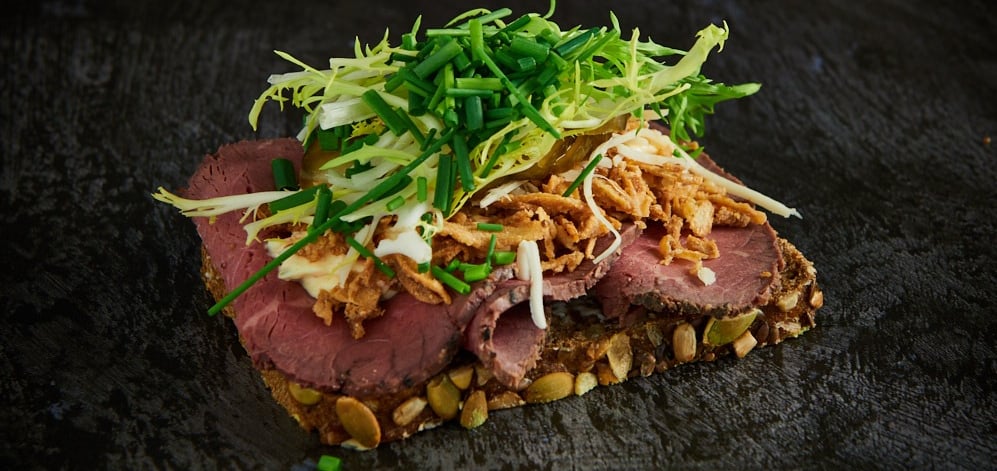

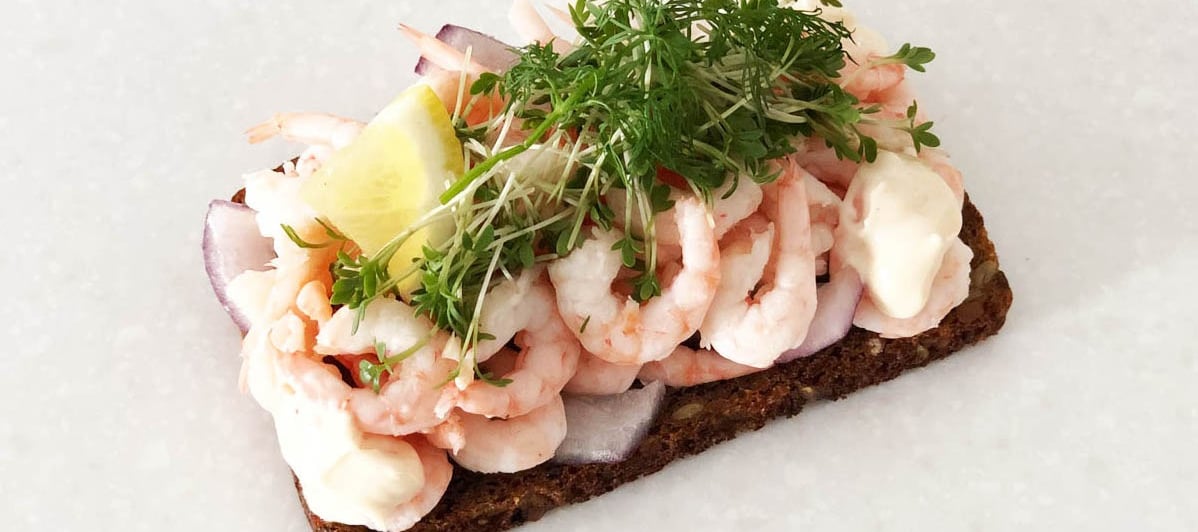

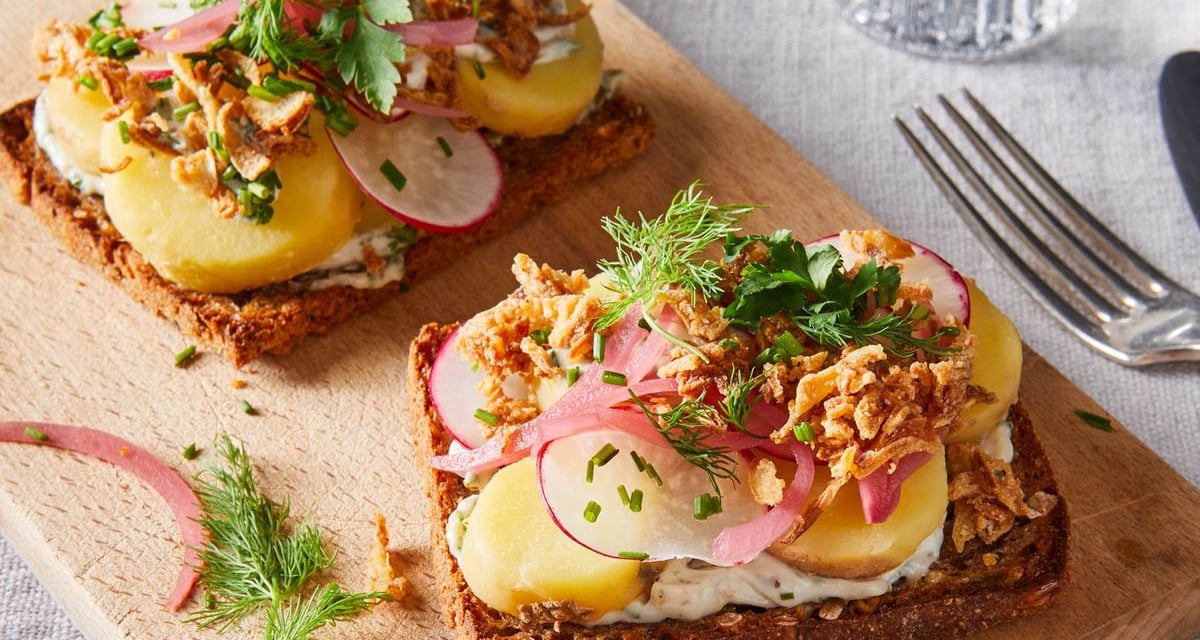



Top 5 Danish Smørrebrød and their Recipes
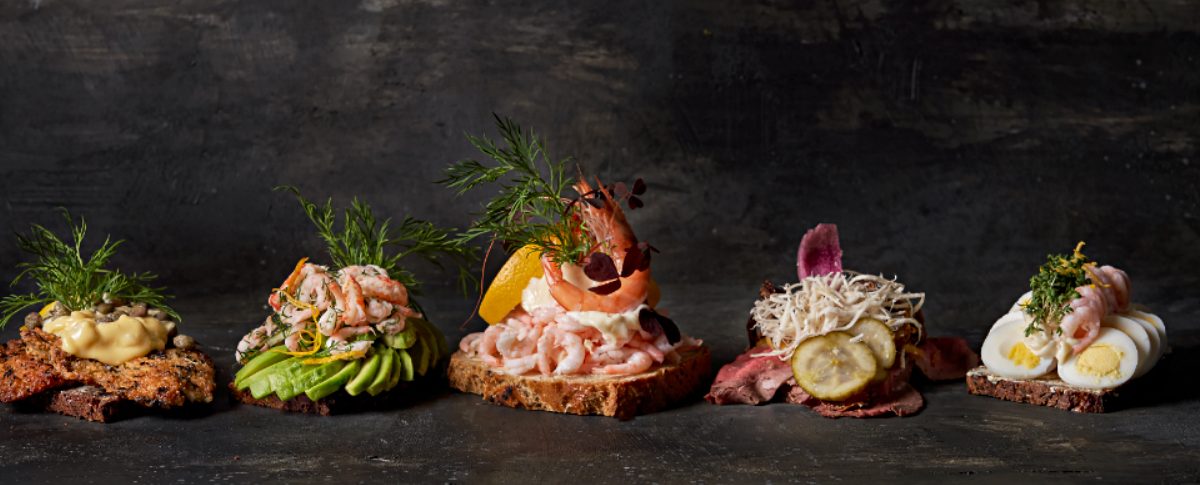

Welcome to my world of creative expression! Based in the heart of Copenhagen but reaching customers worldwide, I bring over 500 unique designs to life on t-shirts, hoodies, mugs, and more. Passionate about graphic design, I combine Nordic inspiration with global appeal to offer stylish, high-quality merchandise through Shopify/Printify and Teepublic. Whether you’re looking for a cozy sweatshirt or a personalized Coffee Mug, each product is crafted to make everyday moments extraordinary.
Explore, express, and enjoy!
Advertisment for our Merchndise Shop












